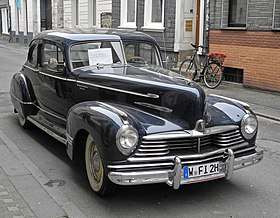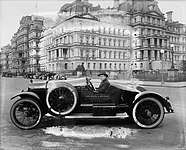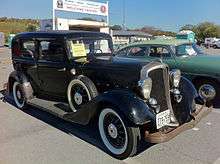Hudson Super Six
The Hudson Super Six Coach is an automobile which was first manufactured by the Hudson Motor Car Company of Detroit, Michigan in 1916. The first model was kept in production until 1928. The nameplate was revived for a rebadged Essex for 1933 (single model year only), and then returned again from 1940 until 1951, aside from a wartime hiatus. The 1951s were actually called "Hudson Super Custom Six".
| Hudson Super Six | |
|---|---|
 1948-1950 Hudson Super Six | |
| Overview | |
| Manufacturer | Hudson Motor Car Company |
| Model years |
|
| Assembly | Detroit, MI, United States |
| Body and chassis | |
| Class | Full-size car |
| Layout | FR layout |
| Chronology | |
| Successor |
|
First generation (1916)
The first Hudson Super Six was introduced on 16 January, 1916. Also known as the Series H, the Super Six was an early performance car. Its 288.5 cu in (4.7 L) inline-six developed 76 hp (57 kW), compared to the 40 hp (30 kW) of the equally dimensioned engine fitted to the contemporary Hudson Model Six-40.[1] Before its introduction, Super Sixes made a series of speed runs on a track in Long Island, NY, followed by a new record transcontinental run (San Francisco to New York in 5 days, 3 hours, and 31 minutes - returning after an 8-hour break), a stock chassis speed record at Daytona Beach, a record at Pikes Peak, and the stock chassis 24-hour record at an average speed of 74.9 mph (120.5 km/h). The last record stood until 1931, when a Marmon took it.[1]
In John Steinbecks novel The Grapes of Wrath, the Joad family depends on a Hudson Super Six sedan converted into a truck. In the 1940 filmatization, the car used is a 1926 model. This car was put into storage after filming ended and, after having been discovered in a rather dilapidated condition, converted into a Speedster in 2009.[2]
 The 24-hour record-setting special-bodied 1916 Hudson Super Six
The 24-hour record-setting special-bodied 1916 Hudson Super Six.jpg) 1917 production car (Series J Phaeton)
1917 production car (Series J Phaeton).jpg) 1917 open-drive limousine
1917 open-drive limousine
Second generation (1927)
For 1927, the Hudson Super Six received a complete redesign including a new F-head engine, 18-inch wood spoke wheels (rather than 21 inches) and four-wheel brakes.[3] The car was lower and generally more stylish, and power increased from 76 to 92 hp (57 to 69 kW). The lower-cost Model R sat on a 118 1⁄2 in (3,010 mm) wheelbase, while that of the Model S is 127 3⁄8 in (3,240 mm). Two standard bodies were available, a two-door Coach and a four-door Sedan. The Model O was also available with five different Custom bodystyles, made by Biddle and Smart of Massachusetts.[3] The engine was updated in July 1927, with a new manifold and a different head design, including the relocation of the spark plugs and intake valves. Hudson chose not to increase the claimed power, but many consider the stated output to be very conservative.[3]
In 1927, Essex also chose the Super Six label for their cars, while aligning their design with that of the larger Hudsons.[4] Essex kept calling their cars Super Sixes in 1928 and off and on until 1932.[5]
For 1928, the Model O and Model S continued with some styling changes, including a taller and slimmer radiator, larger, more oval headlights, and vertical louvers on the hood. Also new was a standard-bodied Coupe on the Model S chassis, as well as a Biddle and Smart-bodied roadster on the same short wheelbase. Murphy Body of Pasadena designed the custom bodies used on the Model O, although Hudson chose Biddle and Smart to build these designs.[6] For 1929 the Super Six badge was dropped in favor of the "Greater Hudson" label, and for 1930 all Hudsons had eight-cylinder engines. The 1929 R and L models' wheelbases were stretched by about four inches, the wheels were changed to 19-inch wire wheels, but they carried over the Super Six engine as well as the Murphy-designed/Biddle and Smart-made bodies.[3]
Third generation (1933)

Hudson's lesser sister brand Essex had been using the "Super Six" name since model year 1928. The fading Essex brand began 1932 selling their cars as the "Greater Essex Super-Six," then the "Essex Super-Six Pacemaker", and finally as simply the "Essex Pacemaker."[5] This car, largely unchanged, was also sold as the Hudson Super-Six "Pacemaker" in 1933 only, in parallel with the cheaper Essex-Terraplane which was kept in production (minus the "Essex" moniker) for 1934.[7] While the low cost Essex-Terraplane sat on a 106 in (2,700 mm) wheelbase, the Series E Hudson Super-Six has 113 inches (2,900 mm). The engine displaced 193.1 cu in (3.2 L) and produced 73 or 80 hp (54 or 60 kW) depending on the compression ratio.[8]
Fourth generation (1940)
For the 1940 model year, Hudson reintroduced the "Super Six" nameplate again. This time it sat on a six-cylinder version of the new Hudson Eight, sharing that car's 118 in (3,000 mm) wheelbase. This was five inches longer than that of the regular Hudson Six, which was available as either the Traveler or DeLuxe. The regular Six was called Series 40T and 40P respectively, whereas the Super Six was Series 41. The Super Six also received a larger, 212 cu in (3.5 L) engine with 102 hp (76 kW), ten more than the Hudson Six. This engine was also shared with the large Hudson Country Club Six, with its 125 in (3,200 mm) wheelbase, as well as the Hudson Big Boy series of commercial vehicles.
Body styles started with a 3-passenger Coupe or a 5-passenger Victoria Coupe (sharing the same sheetmetal), continuing with a two- or four-door Touring Sedan, and culminating with a two-door Convertible Coupe as well as the two-door Convertible Sedan (seating five people). Marking the period move towards envelope styling and away from separate fenders, all versions could be had with or without running boards at no extra cost.[9]
See also
References
- Kowalke, Ron, ed. (1999). Standard Catalog of Independents: The Struggle to Survive Among Giants. Iola, WI: Krause Publications. p. 49. ISBN 0-87341-569-8.
- Edsall, Larry (2010-01-31). "'The Grapes of Wrath' Car Gets a Redo". New York Times.
- Standard Catalog of Independents, pp. 53-54
- Standard Catalog of Independents, p. 84
- Standard Catalog of Independents, p. 86
- "1929 Hudson Model L Club Sedan by Biddle and Smart" (Auction Description). Hershey, PA: RM Auctions/Sothebys. October 2011. Lot 264. Archived from the original on 2017-10-18.
- Donnelly, Jim (September 2005). "Rolling Sculpture – 1942 Hudson Super Six Wagon". Hemmings Classic Car. American City Business Journals. Archived from the original on 2019-10-25.
- Standard Catalog of Independents, p. 56
- 1940 Hudson: A New Low Cost for Luxury (PDF) (Sales Brochure), Hudson Motor Car Company, 1939, pp. 10–13, Form No. 612-A
Source: Slauson, H. W.; Howard Greene (1926). ""Leading American Motor Cars"". Everyman’s Guide to Motor Efficiency. New York: Leslie-Judge Company.